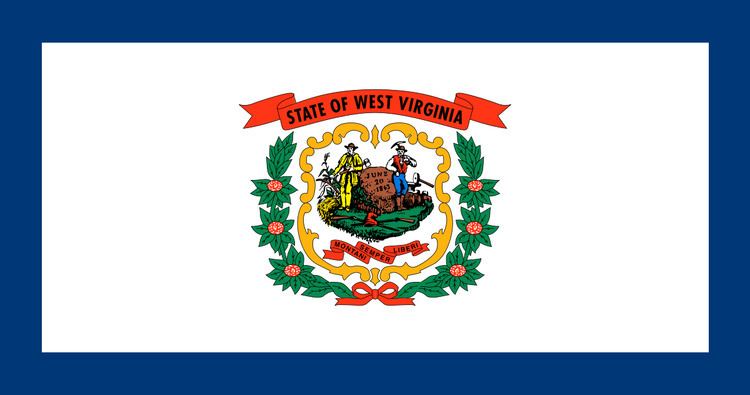 | ||
The West Virginia lunar sample displays are two commemorative plaques consisting of small fragments of moon specimen brought back with the Apollo 11 and Apollo 17 lunar missions and given in the 1970s to the people of the state of West Virginia by United States President Richard Nixon as goodwill gifts.
Contents
Apollo 11
The West Virginia Apollo 11 lunar sample display commemorative plaque consists of four "moon rock" rice-size particle specimens that were collected by Apollo 11 astronauts Neil Armstrong and Buzz Aldrin in 1969 and a small West Virginia state flag that was taken to the moon and back on Apollo 11.
The 4 "moon rocks" weigh about 0.05 grams in total. They are encased in a clear plastic button the size of a coin which is mounted to a wooden board approximately one foot square on a small podium pedestal display. The small podium plaque display also has mounted on it a small West Virginia state flag that had been taken to the moon and back, which lies directly below the "goodwill moon rocks". The small podium plaque display was given to the people of the state of West Virginia as a gift by United States President Richard Nixon. Similar lunar sample displays were also distributed to all the other states of the United States and all the countries (at the time) of the world.
Apollo 17
The West Virginia Apollo 17 lunar sample display commemorative style plaque, measuring 10 by 14 inches, consists of one "moon rock" particle specimen that was cut from lunar basalt 70017 and a West Virginia state flag. The basalt 70017 was collected by Apollo 17 astronaut Harrison Schmitt on the moon in 1972. Once lunar basalt 70017 was brought back to earth from the moon, the basalt moon rock was cut up into small fragments of approximately 1 gram. The specimen was encased in a plastic ball and mounted on the wooden plaque along with the West Virginia state flag which had been taken to the moon and back by the crew of Apollo 17. The plaque was then distributed in 1973 by President Richard Nixon to the state of West Virginia as he did that year to the other 49 states (the same as for the Apollo 11 plaque gifts). This was done as a goodwill gesture to promote peace and harmony.
History
The West Virginia Apollo 17 "goodwill moon rocks" plaque display was presented to the people of the state of West Virginia in 1973. After that it was missing for decades. In June 2010 a graduate student of Joseph Gutheinz, former special agent with NASA and self-appointed investigator of missing "moon rocks" displays, tracked the West Virginia Apollo 17 lunar sample display to the home of a retired dentist in Morgantown, West Virginia. The retired dentist, Robert Conner, had inherited many family heirlooms from his late brother's estate in 2002, and the NASA-gifted Apollo 17 commemorative plaque was one of those items.
Conner speculated that the West Virginia Apollo 17 "goodwill moon rocks" plaque display was received by his late brother, Troy Blaine Conner, Jr. of Moundsville, West Virginia, who was an attorney for the United States Atomic Energy Commission. Conner believes the Apollo 17 lunar sample plaque came by way of a connection with former Governor Arch A. Moore Jr., who was once associated with Troy's Washington law firm. Conner speculated that Moore might have loaned it to Troy one day "to observe".
Conner pointed out that the plaque was so plain and obscure sitting on a shelf at his home that he put no value on it. He didn't realize that the state of West Virginia was looking for it. When contacted by Gutheinz, Conner realized that it had great value and hoped that West Virginia University would wind up with it for public display. He turned it over to the West Virginia Division of Culture and History for their final determination. The State of West Virginia Division of Culture and History already had the West Virginia Apollo 11 "goodwill moon rocks" commemorative podium plaque display in its possession. As of 2012, the museum now has both the Apollo 11 and Apollo 17 lunar plaque displays gifted to the state of West Virginia.
